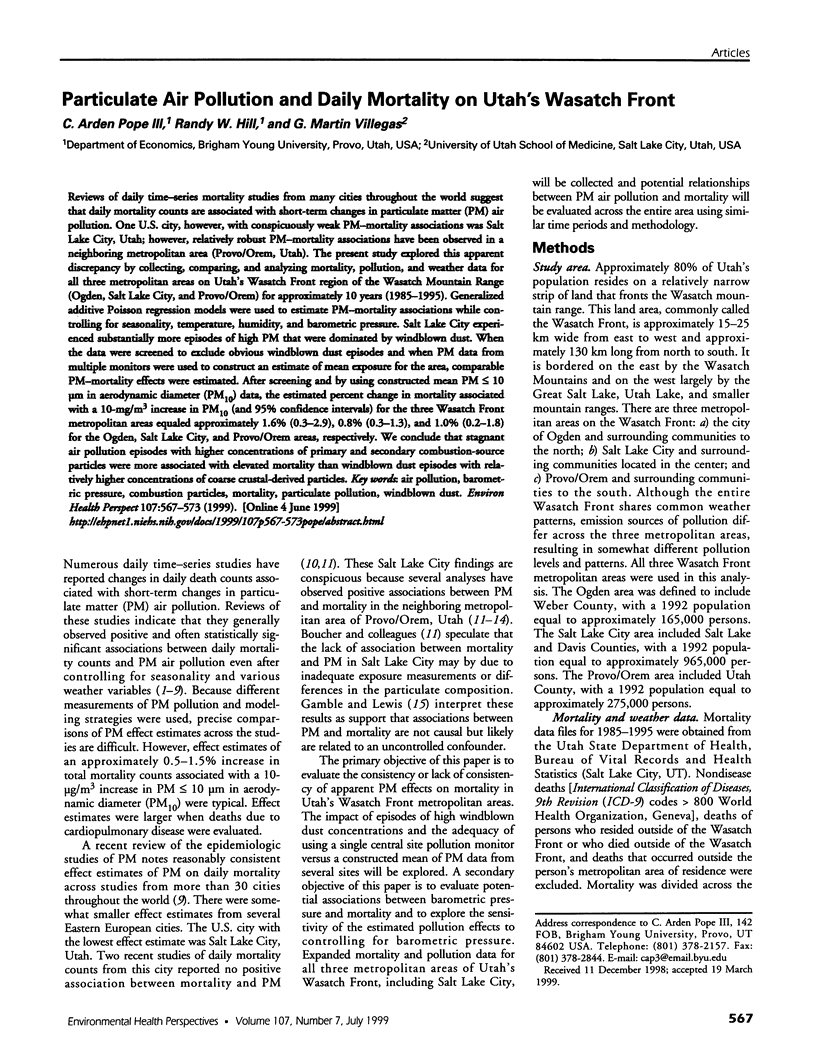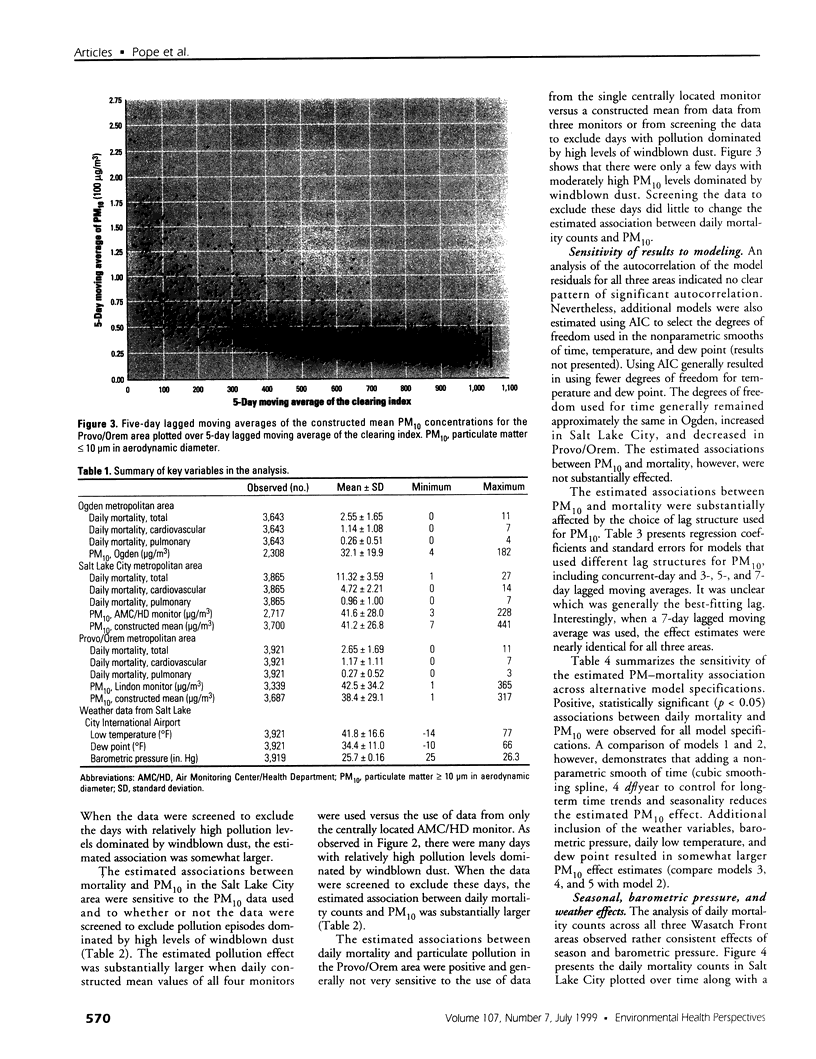Abstract
Reviews of daily time-series mortality studies from many cities throughout the world suggest that daily mortality counts are associated with short-term changes in particulate matter (PM) air pollution. One U.S. city, however, with conspicuously weak PM-mortality associations was Salt Lake City, Utah; however, relatively robust PM-mortality associations have been observed in a neighboring metropolitan area (Provo/Orem, Utah). The present study explored this apparent discrepancy by collecting, comparing, and analyzing mortality, pollution, and weather data for all three metropolitan areas on Utah's Wasatch Front region of the Wasatch Mountain Range (Ogden, Salt Lake City, and Provo/Orem) for approximately 10 years (1985-1995). Generalized additive Poisson regression models were used to estimate PM-mortality associations while controlling for seasonality, temperature, humidity, and barometric pressure. Salt Lake City experienced substantially more episodes of high PM that were dominated by windblown dust. When the data were screened to exclude obvious windblown dust episodes and when PM data from multiple monitors were used to construct an estimate of mean exposure for the area, comparable PM-mortality effects were estimated. After screening and by using constructed mean PM [less than/equal to] 10 microm in aerodynamic diameter (PM10) data, the estimated percent change in mortality associated with a 10-mg/m3 increase in PM10 (and 95% confidence intervals) for the three Wasatch Front metropolitan areas equaled approximately 1. 6% (0.3-2.9), 0.8% (0.3-1.3), and 1.0% (0.2-1.8) for the Ogden, Salt Lake City, and Provo/Orem areas, respectively. We conclude that stagnant air pollution episodes with higher concentrations of primary and secondary combustion-source particles were more associated with elevated mortality than windblown dust episodes with relatively higher concentrations of coarse crustal-derived particles.
Full text
PDF






Images in this article
Selected References
These references are in PubMed. This may not be the complete list of references from this article.
- Dockery D. W., Pope C. A., 3rd Acute respiratory effects of particulate air pollution. Annu Rev Public Health. 1994;15:107–132. doi: 10.1146/annurev.pu.15.050194.000543. [DOI] [PubMed] [Google Scholar]
- Gamble J. F., Lewis R. J. Health and respirable particulate (PM10) air pollution: a causal or statistical association? Environ Health Perspect. 1996 Aug;104(8):838–850. doi: 10.1289/ehp.96104838. [DOI] [PMC free article] [PubMed] [Google Scholar]
- Ostro B. The association of air pollution and mortality: examining the case for inference. Arch Environ Health. 1993 Sep-Oct;48(5):336–342. doi: 10.1080/00039896.1993.9936722. [DOI] [PubMed] [Google Scholar]
- Pope CA3rd, Dockery D. W., Kanner R. E., Villegas G. M., Schwartz J. Oxygen saturation, pulse rate, and particulate air pollution: A daily time-series panel study. Am J Respir Crit Care Med. 1999 Feb;159(2):365–372. doi: 10.1164/ajrccm.159.2.9702103. [DOI] [PubMed] [Google Scholar]
- Pope C. A., 3rd, Bates D. V., Raizenne M. E. Health effects of particulate air pollution: time for reassessment? Environ Health Perspect. 1995 May;103(5):472–480. doi: 10.1289/ehp.95103472. [DOI] [PMC free article] [PubMed] [Google Scholar]
- Pope C. A., 3rd, Kalkstein L. S. Synoptic weather modeling and estimates of the exposure-response relationship between daily mortality and particulate air pollution. Environ Health Perspect. 1996 Apr;104(4):414–420. doi: 10.1289/ehp.96104414. [DOI] [PMC free article] [PubMed] [Google Scholar]
- Pope C. A., 3rd, Schwartz J., Ransom M. R. Daily mortality and PM10 pollution in Utah Valley. Arch Environ Health. 1992 May-Jun;47(3):211–217. doi: 10.1080/00039896.1992.9938351. [DOI] [PubMed] [Google Scholar]
- Pope C. A., 3rd, Schwartz J. Time series for the analysis of pulmonary health data. Am J Respir Crit Care Med. 1996 Dec;154(6 Pt 2):S229–S233. doi: 10.1164/ajrccm/154.6_Pt_2.S229. [DOI] [PubMed] [Google Scholar]
- Schwartz J. Air pollution and daily mortality: a review and meta analysis. Environ Res. 1994 Jan;64(1):36–52. doi: 10.1006/enrs.1994.1005. [DOI] [PubMed] [Google Scholar]
- Styer P., McMillan N., Gao F., Davis J., Sacks J. Effect of outdoor airborne particulate matter on daily death counts. Environ Health Perspect. 1995 May;103(5):490–497. doi: 10.1289/ehp.95103490. [DOI] [PMC free article] [PubMed] [Google Scholar]
- Thurston G. D. A critical review of PM10-mortality time-series studies. J Expo Anal Environ Epidemiol. 1996 Jan-Mar;6(1):3–21. [PubMed] [Google Scholar]
- Vedal S. Ambient particles and health: lines that divide. J Air Waste Manag Assoc. 1997 May;47(5):551–581. doi: 10.1080/10473289.1997.10463922. [DOI] [PubMed] [Google Scholar]






